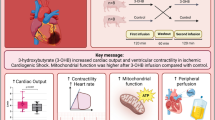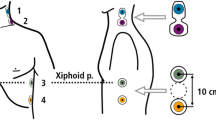Abstract
Little information is available about how intravenous bolus injection of iopromide 370 twice in a short time will affect hemodynamics and whether the changes reach clinically relevant levels. In the present study, 31 healthy adult volunteers received abdominal contrast-enhanced CT and coronary CTA sequential examinations. The same dose and rate of normal saline was injected 30 min in advance as self-control. Hemodynamic data were noninvasively collected at selected time points from 1 min prior to injection to 30 min post-injection. The results showed that after iopromide 370 injection, except for stroke volume, all other indicators changed immediately during the first injection, changed most significantly during the second injection (P < 0.05), and returned to baseline within 10 min. Heart rate and cardiac output exhibited the most pronounced changes, with an increasing rate of 33.5% and 33.8%, respectively. For indicators with a change range of > 15% during the second injection, except for mean arterial pressure and total peripheral resistance, the proportions of subjects for the other indicators between the two groups were statistically different (P < 0.05). In conclusion, intravenous bolus injection of iopromide 370 twice in dual-site sequential examinations induced dose-cumulative and time-dependent hemodynamic effects, which all fluctuated within the normal ranges.
Graphical abstract





Similar content being viewed by others
Abbreviations
- NICM:
-
Non-ionic iodinated contrast media
- CECT:
-
Contrast-enhanced CT
- ADR:
-
Adverse drug reactions
- SBP:
-
Systolic blood pressure
- DBP:
-
Diastolic blood pressure
- MAP:
-
Mean arterial pressure
- HR:
-
Heart rate
- CO:
-
Cardiac output
- SV:
-
Stroke volume
- TPR:
-
Total peripheral resistance
- NS:
-
Normal saline
References
Li X, Chen J, Zhang L, Liu H, Wang S, Chen X et al (2015) Clinical observation of the adverse drug reactions caused by non-ionic iodinated contrast media: results from 109,255 cases who underwent enhanced CT examination in Chongqing, China. Br J Radiol 88(1047):20140491
Li X, Liu H, Zhao L, Liu J, Cai L, Liu L et al (2017) Clinical observation of adverse drug reactions to non-ionic iodinated contrast media in population with underlying diseases and risk factors. Br J Radiol 90(1070):20160729
Li X, Liu H, Zhao L, Liu J, Cai L, Zhang L et al (2018) The effect of preparative solid food status on the occurrence of nausea, vomiting and aspiration symptoms in enhanced CT examination: prospective observational study. Br J Radiol 91(1090):20180198
Liu H, Liu Y, Zhao L, Li X, Zhang W (2021) Preprocedural fasting for contrast-enhanced CT: when experience meets evidence. Insights Imaging 12(1):180
Liu H, Zhao L, Liu J, Lan F, Cai L, Fang J et al (2022) Change the preprocedural fasting policy for contrast-enhanced CT: results of 127,200 cases. Insights Imaging 13(1):29
Böhm IB, van der Molen AJ (2020) Recommendations for standardized documentation of contrast medium-induced hypersensitivity. J Am Coll Radiol: JACR 17(8):1027–1028
Zhang BC, Wu Q, Wang C, Li DY, Wang ZR (2014) A meta-analysis of the risk of total cardiovascular events of isosmolar iodixanol compared with low-osmolar contrast media. J Cardiol 63(4):260–268
Shi MG, Wang MP, J Ym (2013) A clinical guide for radiological technologist. People's Medical Publishing House(PMPH) p 246–347.
Morcos SK, Dawson P, Pearson JD, Jeremy JY, Davenport AP, Yates MS et al (1998) The haemodynamic effects of iodinated water soluble radiographic contrast media: a review. Eur J Radiol 29(1):31–46
Aspelin P, Stacul F, Thomsen HS, Morcos SK, van der Molen AJ (2006) Effects of iodinated contrast media on blood and endothelium. Eur Radiol 16(5):1041–1049
Spataro RF, Katzberg RW, Fischer HW, McMannis MJ (1987) High-dose clinical urography with the low-osmolality contrast agent Hexabrix: comparison with a conventional contrast agent. Radiology 162(1 Pt 1):9–14
Chartrand-Lefebvre C, White CS, Bhalla S, Mayo-Smith WW, Prenovault J, Vydareny KH et al (2011) Comparison of the effect of low- and iso-osmolar contrast agents on heart rate during chest CT angiography: results of a prospective randomized multicenter study. Radiology 258(3):930–937
Bach R, Jung F, Scheller B, Hummel B, Ozbek C, Spitzer S et al (1996) Influence of a non-ionic radiography contrast medium on the microcirculation. Acta Radiologica (Stockholm, Sweden: 1987) 37(2):214–7
Jung F, Matschke K, Mrowietz C, Tugtekin SM, Geissler T, Keller S et al (2003) Influence of radiographic contrast media on myocardial tissue oxygen tension: NaCl-controlled, randomised, comparative study of iohexol versus iopromide in an animal model. Clin Hemorheol Microcirc 29(1):53–61
Lasser EC, Lamkin GE (2002) Mechanisms of blood pressure change after bolus injections of X-ray contrast media. Acad Radiol 9(Suppl 1):S72–S75
Widmann G, Bale R, Ulmer H, Putzer D, Schullian P, Wiedermann FJ et al (2018) Systemic hypotension following intravenous administration of nonionic contrast medium during computed tomography: iopromide versus iodixanol. Anesth Analg 126(3):769–775
Becker CR, Vanzulli A, Fink C, de Faveri D, Fedeli S, Dore R et al (2011) Multicenter comparison of high concentration contrast agent iomeprol-400 with iso-osmolar iodixanol-320: contrast enhancement and heart rate variation in coronary dual-source computed tomographic angiography. Invest Radiol 46(7):457–464
Svensson A, Ripsweden J, Rück A, Aspelin P, Cederlund K, Brismar BT (2010) Heart rate variability and heat sensation during CT coronary angiography: low-osmolar versus iso-osmolar contrast media. Acta radiologica (Stockholm, Sweden: 1987) 51(7):722–6
John AM, Yadav S (2019) Effect of bolus administration of non-ionic radiopaque contrast media on blood pressure variation. Radiography (London, England: 1995) 25(4):346–48
Szolar DH, Saeed M, Flueckiger F, Preidler K, Stiskal MA, Watzinger N et al (1995) Effects of iopromide on vasoactive peptides and allergy-mediated substances in healthy volunteers. Invest Radiol 30(3):144–149
Bergstra A, van Dijk RB, Brekke O, Buurma AE, Orozco L, den Heijer P et al (2000) Hemodynamic effects of iodixanol and iohexol during ventriculography in patients with compromised left ventricular function. Catheter Cardiovasc Interv : official journal of the Society for Cardiac Angiography & Interventions 50(3):314–321
Schmid I, Didier D, Pfammatter T, Garachemani A, Fleisch M, Kirchin MA et al (2007) Effects of non-ionic iodinated contrast media on patient heart rate and pressures during intra-cardiac or intra-arterial injection. Int J Cardiol 118(3):389–396
Tveit K, Bolz KD, Bolstad B, Haugland T, Berg KJ, Skjaerpe T et al (1994) Iodixanol in cardioangiography. A double-blind parallel comparison between iodixanol 320 mg I/ml and ioxaglate 320 mg I/ml. Acta radiologica (Stockholm, Sweden: 1987) 35(6):614–8
Manninen H, Tahvanainen K, Borch K, Wallén T, Soimakallio S, Matsi P et al (1995) Iodixanol, a new non-ionic, dimeric contrast medium in cardioangiography: a double-blind, parallel comparison with iopromide. Eur Radiol 5:364–370
Andersen PE, Bolstad B, Berg KJ, Justesen P, Kloster YF (1993) Iodixanol and ioxaglate in cardioangiography: a double-blind randomized phase III study. Clin Radiol 48(4):268–272
Bergelson B, Bettmann MA, Wexler L, Wilson R, Dyet J (1994) Comparison of iopromide with iohexol and iopamidol in coronary arteriography and left ventriculography. Investig Radiol 29(Suppl 1):S107-11
Qian G, Yang YQ, Dong W, Cao F, Chen YD (2017) Comparison of iodixanol and iopromide in patients with renal insufficiency and congestive heart failure undergoing coronary angiography by hemodynamic monitoring. Angiology 68(10):907–913
Shen Wen, Yin Jianzhong (2018) Clinical application of multi-site combined contrast-enhanced CT. China People’s Medical Publishing House
Davenport MS, Khalatbari S, Cohan RH, Dillman JR, Myles JD, Ellis JH (2013) Contrast material-induced nephrotoxicity and intravenous low-osmolality iodinated contrast material: risk stratification by using estimated glomerular filtration rate. Radiology 268(3):719–728
Böhm I, Nairz K, Morelli JN, Keller PS, Heverhagen JT (2017) Iodinated contrast media and the alleged “iodine allergy”: an inexact diagnosis leading to inferior radiologic management and adverse drug reactions. RoFo : Fortschritte auf dem Gebiete der Rontgenstrahlen und der Nuklearmedizin 189(4):326–332
Masui T, Katayama M, Kobayashi S, Sakahara H (2005) Intravenous injection of high and medium concentrations of computed tomography contrast media and related heat sensation, local pain, and adverse reactions. J Comput Assist Tomogr 29(5):704–708
Mark DB, Berman DS, Budoff MJ, Carr JJ, Gerber TC, Hecht HS et al (2010) ACCF/ACR/AHA/NASCI/SAIP/SCAI/SCCT 2010 expert consensus document on coronary computed tomographic angiography: a report of the American College of Cardiology Foundation Task Force on Expert Consensus Documents. Circulation 121(22):2509–2543
Leipsic J, Labounty TM, Hague CJ, Mancini GB, O’Brien JM, Wood DA et al (2012) Effect of a novel vendor-specific motion-correction algorithm on image quality and diagnostic accuracy in persons undergoing coronary CT angiography without rate-control medications. J Cardiovasc Comput Tomogr 6(3):164–171
Ukor IF, Hilton AK, Bailey MJ, Bellomo R (2017) The haemodynamic effects of bolus versus slower infusion of intravenous crystalloid in healthy volunteers. J Crit Care 41:254–259
Koeda T, Motegi I, Ichikawa T, Suzuki T, Kato M (1987) Changes in hemodynamics due to the contrast medium during left ventriculography. Angiology 38(11):825–832
Dawson P (1989) Cardiovascular effects of contrast agents. Am J Cardiol 64(9):2e–9e
Kinnison ML, Powe NR, Steinberg EP (1989) Results of randomized controlled trials of low-versus high-osmolality contrast media. Radiology 170(2):381–389
Franke RP, Fuhrmann R, Hiebl B, Jung F (2008) Influence of various radiographic contrast media on the buckling of endothelial cells. Microvasc Res 76(2):110–113
Mrowietz C, Franke RP, Jung F (2012) Influence of different radiographic contrast media on the echinocyte formation of human erythrocytes. Clin Hemorheol Microcirc 50(1–2):35–47
Gerber KH, Higgins CB, Yuh YS, Koziol JA (1982) Regional myocardial hemodynamic and metabolic effects of ionic and nonionic contrast media in normal and ischemic states. Circulation 65(7):1307–1314
Funding
This work was supported by the Fund of Chongqing 2019 Science and Technology Joint Medical Research Project (2019ZDXM049).
Author information
Authors and Affiliations
Contributions
Guarantors of integrity of entire study, H.L., X.L.; study concepts/study design, H.L., X.L.; data acquisition or data analysis/interpretation, all authors; manuscript drafting for important intellectual content, L.R.W., H.Y.Q; approval of final version of submitted manuscript, all authors; agrees to ensure any questions related to the work are appropriately resolved, all authors; clinical studies, all authors; statistical analysis, L.R.W., H.L.; and manuscript editing, H.L., X.L.
Corresponding authors
Ethics declarations
Conflict of interest
The authors declare no competing interests.
Additional information
Publisher's note
Springer Nature remains neutral with regard to jurisdictional claims in published maps and institutional affiliations.
Supplementary Information
Below is the link to the electronic supplementary material.
Rights and permissions
Springer Nature or its licensor (e.g. a society or other partner) holds exclusive rights to this article under a publishing agreement with the author(s) or other rightsholder(s); author self-archiving of the accepted manuscript version of this article is solely governed by the terms of such publishing agreement and applicable law.
About this article
Cite this article
Wang, L., Qiu, H., Chen, L. et al. Hemodynamic effects of intravenous bolus injection of iopromide 370 twice in abdominal contrast-enhanced CT and coronary CTA dual-site sequential examinations. Med Biol Eng Comput 61, 179–194 (2023). https://doi.org/10.1007/s11517-022-02705-x
Received:
Accepted:
Published:
Issue Date:
DOI: https://doi.org/10.1007/s11517-022-02705-x




